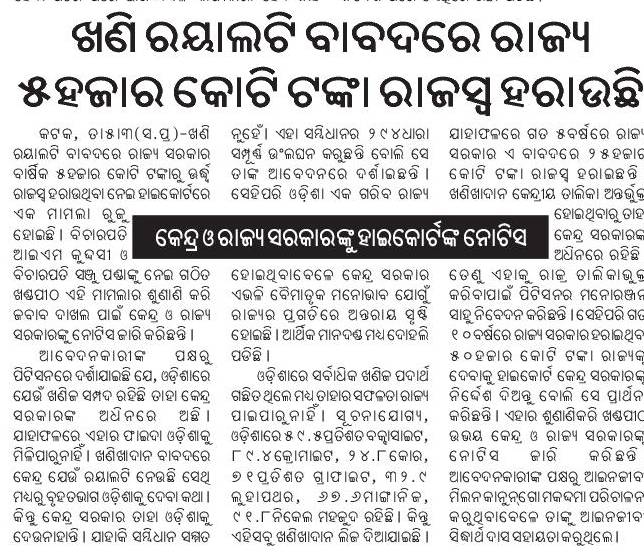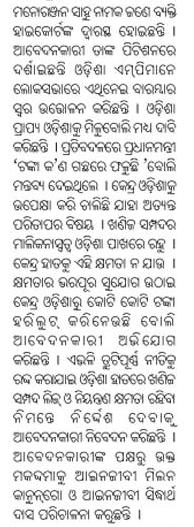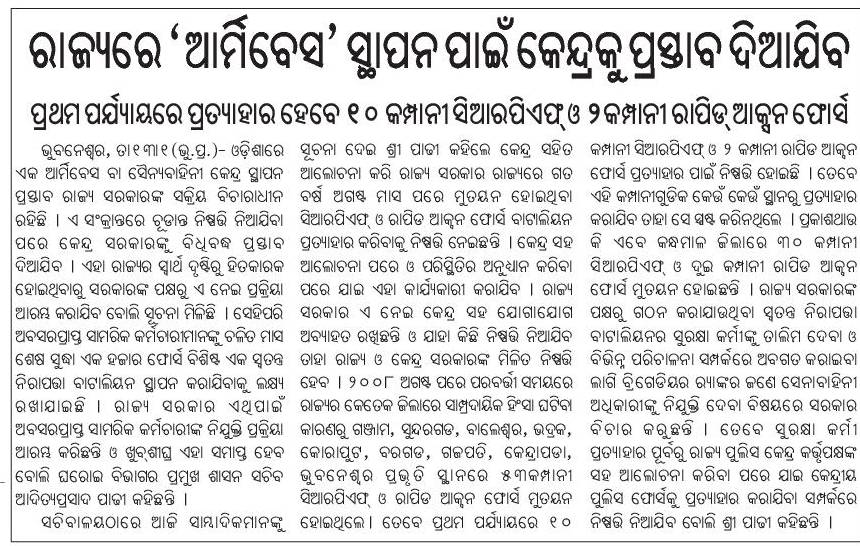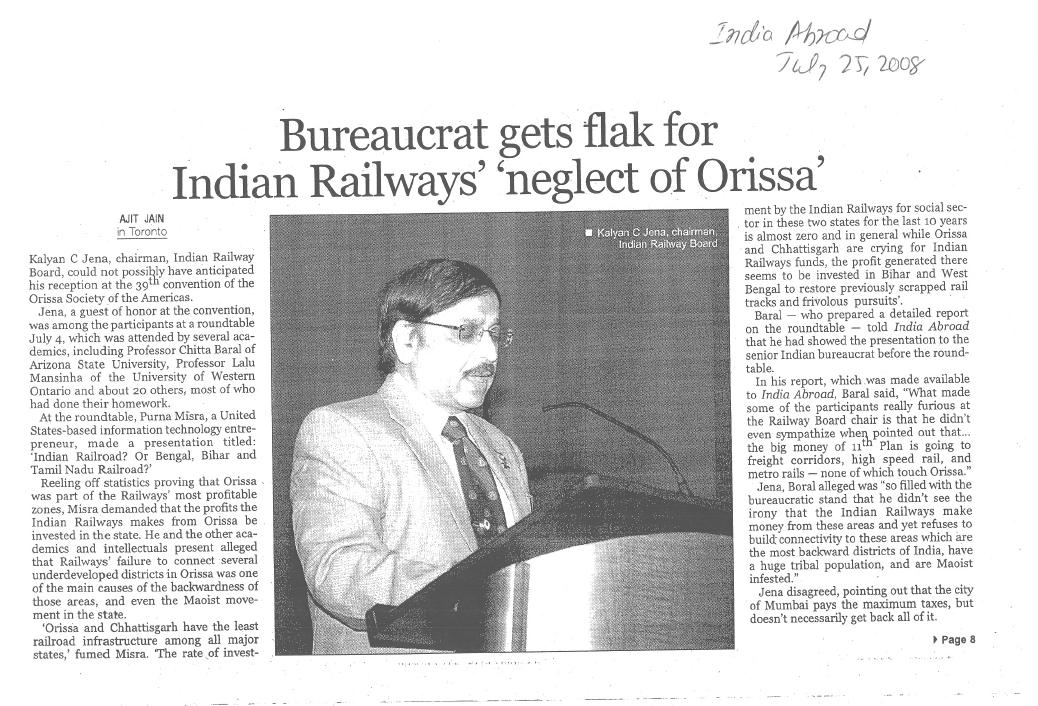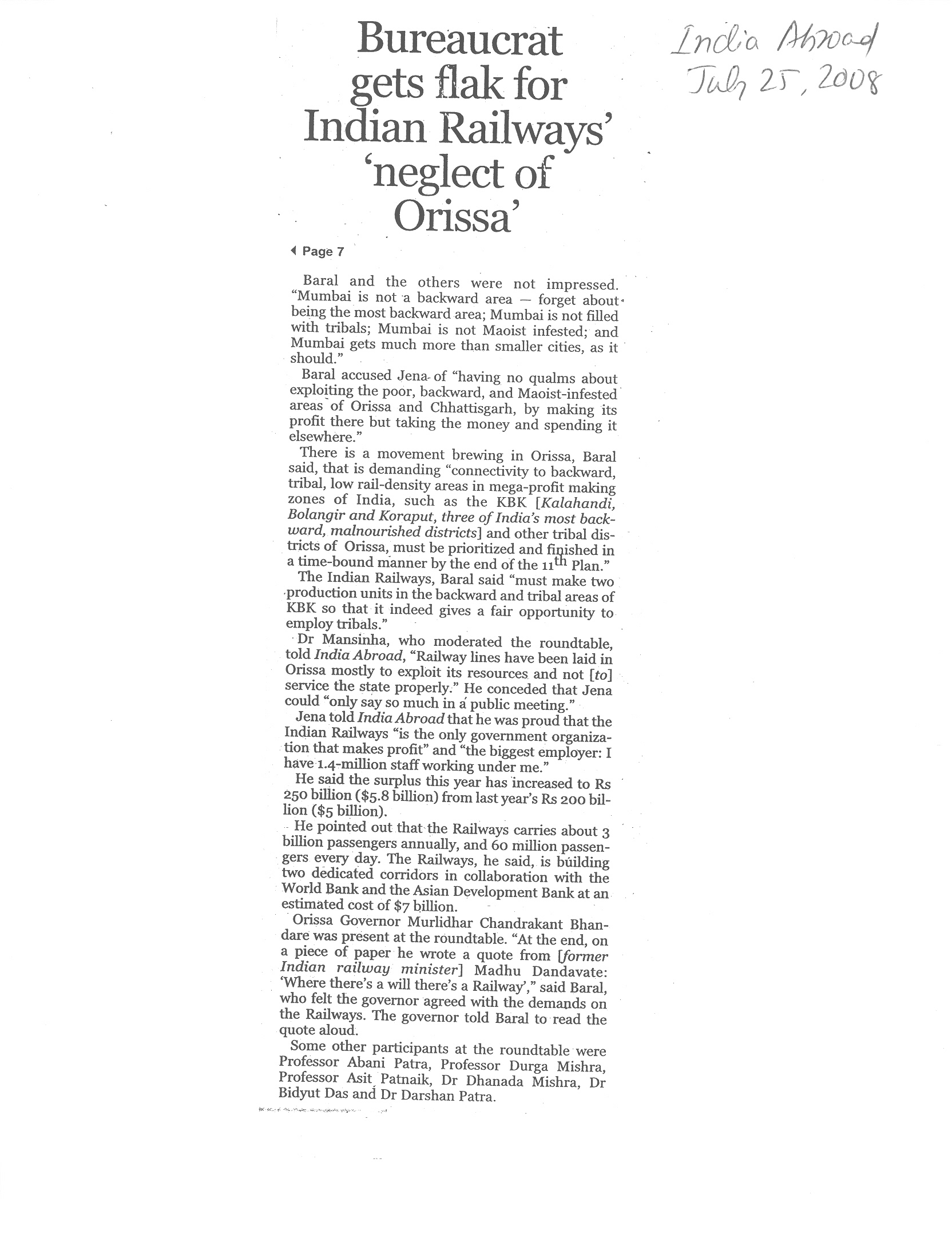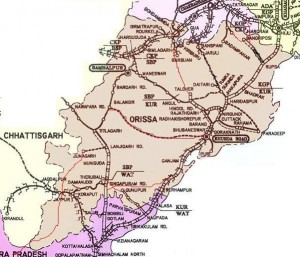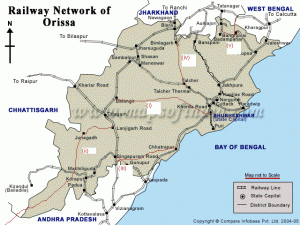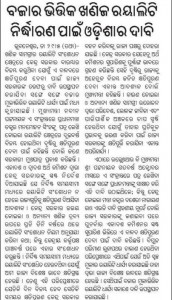|
From Fiscal Turnaround to Rapid and Inclusive Growth
Forthcoming World Bank Study
Overview: Orissa has transformed from a seriously lagging state to a state on the move
From being the poorest state of India in the mid 1990s, Orissa has become a state on the move. The state’s economy has shifted gear and is on a higher growth trajectory. Gross state domestic product (GSDP) has grown at 8.5 percent on average during the Tenth Plan period (2002-07), compared to 5.5 percent during the previous plan (1997-2002) and even slower in the past.
Public investments in infrastructure have begun to rise, and private industrial investment is booming. The finances of the state have improved remarkably, creating fiscal space for expanding public investments.
Private investment is booming: Indian and foreign mega investments in the steel and power sectors and aluminum and chrome products are dominating the private investment boom. Industry has grown at 20 percent annually in 2002-07, compared to only 6 percent in 1997-2002. This is fuelled, in part, by the rise in world metal prices. Since 2004, Orissa has ranked as the country’s premier investment destination, according to the Center for Monitoring the Indian Economy (CMIE).
Private investments under implementation in Orissa now total about US$125 billion – which is about seven times the state’s annual gross domestic product (GSDP). Many of these investments are at an advanced stage and expected to start production before 2012/13. This makes it likely that Orissa will enjoy high double digit growth, faster than the rest of India, for several years to come.
Early signs of economic diversification: There are also some, albeit early signs of economic diversification. In the services sector for instance, Indian IT companies are entering Orissa as traditionally favored destinations become increasingly saturated. The services sector is now growing at a rapid clip, almost touching 10 percent. Even agriculture, traditionally beset by drought and floods, grew at 3 percent per year during 2002-07, which is better than the rest of India.
As a result, Orissa’s per-capita income, which progressively fell behind the rest of the country during the past five decades, has begun to catch up. Inequalities within Orissa have also narrowed. The latest National Sample Survey data show that rural families in the southern region of the state – one of the poorest parts of the country without the mineral deposits of the north – are now spending up to 25 percent more on basic necessities like food, clothing, and schooling for their children, compared to just five years ago. Although average spending in rural Orissa is still low, it is moving up more rapidly than ever before.
A great deal still remains to be done
Second poorest state in the country: Despite recent progress, however, Orissa is still the second poorest state in the country with one of the lowest levels of urbanization. Over 45 percent of its people live in poverty with the scheduled tribes (STs) – who make up a sizeable 22 percent of the state’s population – lagging far behind the rest of the population. Most STs live in tiny villages or remote habitations in the hills where their geographical isolation underlies much of their poverty. Rural electrification is among the lowest in the country; some 18,000 villages and 5 million households have yet to get electricity. Learning levels in schools are low, and the burden of ill health too high.
Capacity constraints in infrastructure: Capacity constraints in rail are increasing congestion on roads, and limited port capacity is diverting cargo from Paradip in Orissa to Haldia in West Bengal, and Vishakhapatnam in Andhra Pradesh. The state has yet to capitalize on its large coastline facing South East Asia.
Undoubtedly, much remains to be done. Given the state’s recent growth, the time is now ripe to consolidate the gains of the past and devote public resources to building infrastructure, and reducing the gaps between the people – between rural and urban, between the interior and the coast, and between the scheduled tribes and the rest of the population.
Policies will need to unleash the full potential of agriculture, fisheries and forestry on which an overwhelming 85 percent of the state’s people depend. Education and health will need urgent attention if the people are to benefit from the growing opportunities provided by the new economy. Roads, railways and ports will need major upgrades if the benefits of growth are to be spread more equitably and the state’s natural resources effectively utilized. And, for all this to happen, the accountability of the government in the delivery of basic services must be increased.
While Orissa seeks to industrialize on the strength of its rich mineral wealth, it is important to ensure that those who live on mineral-rich land benefit adequately from the advent of large mineral-based industries. While the Orissa government has adopted a progressive rehabilitation and resettlement policy for the displaced, and legislated to ensure that a share of company profits are earmarked for development, the challenge ahead lies in the effective implementation of these promising policies.
As Orissa strives to build for the future and surpass average Indian living standards by 2020, it can take productive lessons from its recent successes. The open and consultative process that has served it well in the past will be necessary to deal effectively with the complex issues that lie ahead on the road to modernization.
Reforms Spur Faster Economic Growth
Since 2001,Orissa has achieved a remarkable fiscal turnaround. The ratio of the state’s debt burden to annual GDP has fallen significantly, helping it transform from being one of the most fiscally-stressed states of the country in the late 1990s, with a primary (non-interest) fiscal deficit of 6 percent of GSDP, to a surplus of 3.4 percent.
The turnaround has been triggered by a number of factors. Policy reforms at the central and state level have spurred the arrival of industry, the state government’s strong resolve has helped to complete long pending infrastructure projects despite a resource crunch, and its consultative approach has enabled it to reduce expenditures:
National level reforms: The central government’s elimination of the freight equalization subsidy – that prevented Orissa from becoming an attractive location for mineral based manufacturing in the past – paved the way for arrival of the metal industry in the state.
State government efforts to improve the investment climate: This was followed by a wave of well-sequenced state level reforms. In the first instance, from 2000 to 2003, the government mainly concentrated on raising its revenues through tax reforms and improving the investment climate by simplifying the regulations.
Between 2004 and 2006, it undertook significant measures to contain unproductive public expenditures. Through a consultative and transparent process, the state government took the people on board in its efforts to rightsize the civil service, retrench employees of loss making public enterprises, and rationalize grants to non-government high schools and colleges. The growing private sector presence that had already begun to open up new job opportunities for the people, helped gain their acceptance for the government’s efforts to downsize the public sector.
Improved connectivity: Strong resolve and a focus on outcomes rather than outlays helped the government to complete long-pending construction projects – roads, bridges and irrigation canals – despite constrained budgets. As a result, the number of bridges completed rose from 19 in 2004 to over 100 in 2006.
CHALLENGES AHEAD:
Over 45 percent of Orissa’s people still live in poverty with almost half of them belonging to the Scheduled Tribes, most of whom live in remote villages with little migration to the cities. There are large gaps in the delivery of basic services. The state still has large untapped potential for economic growth.
Improved transport and power connectivity: Almost half the villages in Orissa are small and isolated – with less than 500 residents. As geographical isolation poses a big challenge for connectivity, adequate road, rail, and port infrastructure is essential for inclusive growth as well as to benefit from the state’s mineral endowments.
Urban infrastructure: Although Orissa has one of India‘s lowest levels of urbanization – 15% – its urban centers are growing rapidly. With the growing advent of industry, tourism and IT services, the demand for urban housing, water and power services is likely to increase many times over. Massive upgrading of urban infrastructure is therefore needed to attract and retain the skilled labor force demanded by modern industry and services.
Agricultural and forestry growth: While some 85% of the state’s population remains dependent on agriculture, fisheries and forestry, these sectors are beset by low yields, excessive middlemen, poor connectivity, and lack of storage facilities. The ban on land leasing has resulted in informal and illegal share-cropping arrangements that are harmful to cultivators. To improve the rates of return from farming, the state has amended the agricultural products marketing act to permit privately run mandis and contract farming. The computerization of land records is ongoing. Yet, reforms in land tenure and land administration are needed so that small farmers can access bank credit and make productive investments in the land. For the mostly tribal populations that are dependent on forest produce, joint forest management practices can be a promising route to higher incomes.
Education: While school enrollment has risen, learning levels remain very low. While the state government has launched bold measures to improve teacher accountability, strong educational fundamentals from the earliest years, supplemented by some public and mostly private efforts in training and skill development are needed.
Health: Despite dramatic improvements in overall infant mortality rates in the past 5–10 years, the predominantly tribal districts lag behind. They have the poorest immunization rates and least access to antenatal care. While the state government’s health sector plan for 2005 envisages a decentralized and participatory approach to service delivery, innovative and flexible approaches will be required to reach geographically isolated villages. Importantly, systems of accountability will need to be strengthened before budget allocations to education, healthcare, and anti-poverty programs are increased.
Small and Medium Enterprises: With the arrival of new mega projects, the demand for a wide range of goods and services will rise, generating opportunities for small investors as well as new avenues for employment. To capitalize on these opportunities, an improved regulatory climate for SMEs is called for.
Environmental considerations while tapping mineral rich areas: Given that mineral-based industries impact the environment, there is need to strengthen environmental institutions. Ongoing plans and current efforts of the government toward strengthening public consultation mechanisms will play a crucial role in determining the sustainability of mineral sector investments in Orissa.
QUESTIONS & ANSWERS
1. How many people have been brought out of poverty in recent years?
Between 1999/00 and 2004/05, based on NSS data estimates using ‘mixed reference period’, the proportion of people in poverty in rural Orissa declined by 8 percentage points compared to 5 percentage points in rural India as a whole. Despite this progress, however, the level of poverty in Orissa remains significantly higher than the rest of India.
According to the latest calculation based on official figures released recently by the Planning Commission, the number of poor in Orissa has come down by about 1.5 million between 1999/00 and 2004/05. This figure will feature in the final Bank report.
2. By how much has Orissa’s economy grown in recent years?
The rate of economic growth depends on the period one considers. According to the latest data released by the Directorate of Economics and Statistics, Government of Orissa, the state GDP grew at 10.5 percent annually on average during the most recent five years, that is 2003/04 to 2007/08. During the Tenth Five-Year Plan period, that is 2002/03 to 2006/07, the average growth rate was 8.5 percent. Clearly, Orissa, which grew much slower than the rest of India during the 1990s, has now caught up. From about 2004 onwards, it has begun to overtake the national average.
3. What is the state’s current debt burden?
How the debt burden has moved can be appreciated by comparing not rupee figures but the ratio of the debt burden to annual GDP or annual revenue. As a proportion of revenue, Orissa’s debt has fallen from 343 percent in 2001/02 to 201 percent in 2007/08. As a proportion of GSDP, it has declined from 63 percent to 50 percent. This is a major correction, and reflects responsible fiscal management to lift the state out of a crisis situation.
4. Has the government achieved a revenue surplus by curtailing capital expenditure and squeezing development expenditure?
The revenue surplus has been achieved as a result of 3 factors: improved performance of the state’s own taxes, enhanced central transfers and external donor support, and curtailing of expenditure. The capital budget was constrained during 2002-05, but still outcomes improved due to emphasis on project completion. As explained in the report, there was undoubtedly a lot of flab in the administrative machinery, and Orissa was more over-staffed than other states. The government undertook major surgery to trim the fat, and in the process some muscle also got cut, which needs to be rebuilt now. The Government of Orissa has been hiring a large number of para-teachers, and the teacher-pupil ratio is 40 on average, ranging from 31 in the best served district to 60 in the worst. This is far better than the situation in Bihar, Jharkhand, Karnataka Madhya Pradesh, Uttar Pradesh and West Bengal.
5. Has the signing of MOUs been interpreted as industrial growth?
The reported industrial growth in recent years is based on actual and officially estimated GSDP figures, not on MOUs. Assessment of future prospects has been informed by CMIE’s projections using detailed information on the status of each investment project under implementation, and its likely date of completion based on historical experience and informed judgment in exceptional cases.
6. What is the evidence of crop diversification?
The report cites some signs of crop diversification. For instance, the output of maize and cotton has increased in some areas; this is reflected in official agricultural crop statistics.
|

